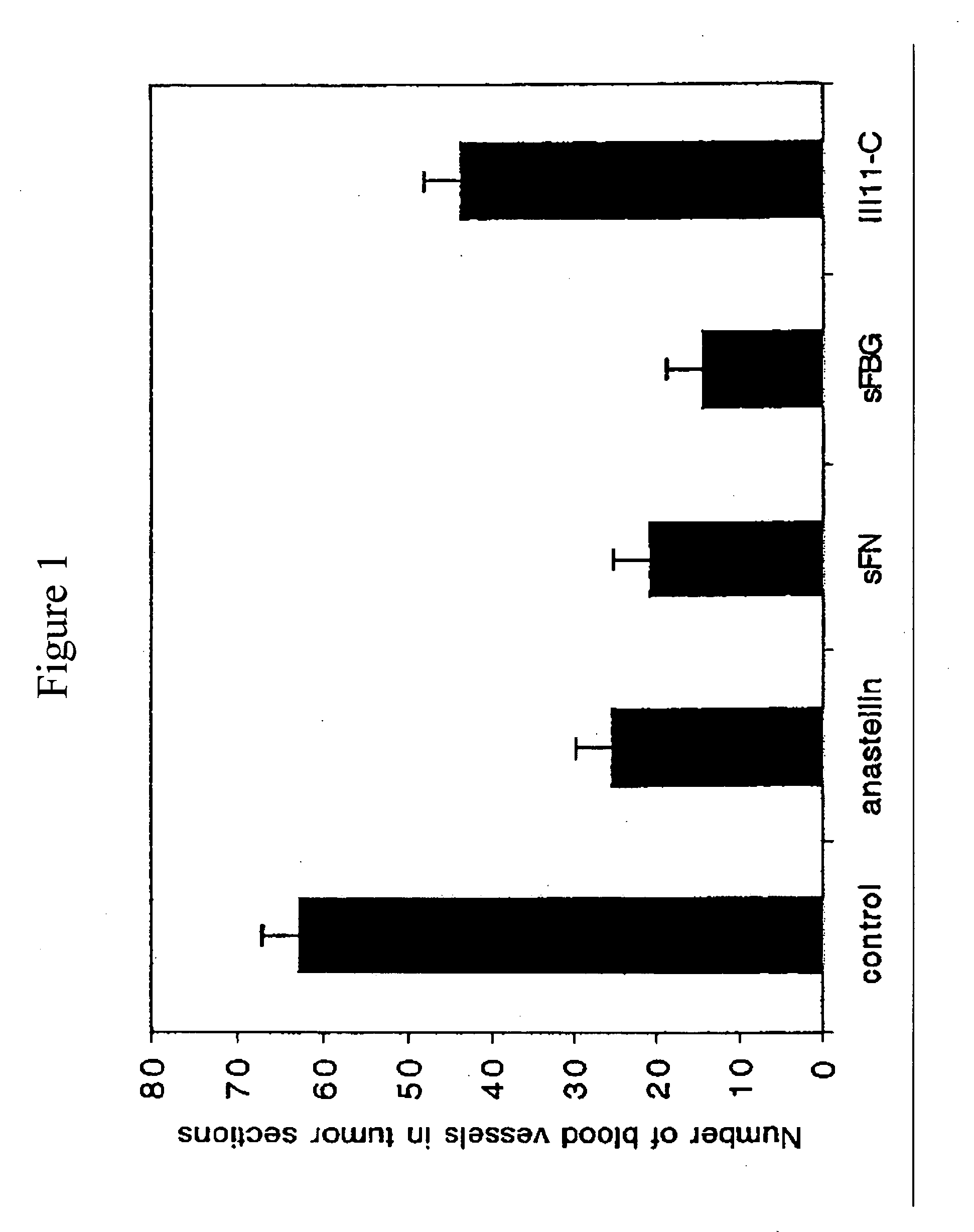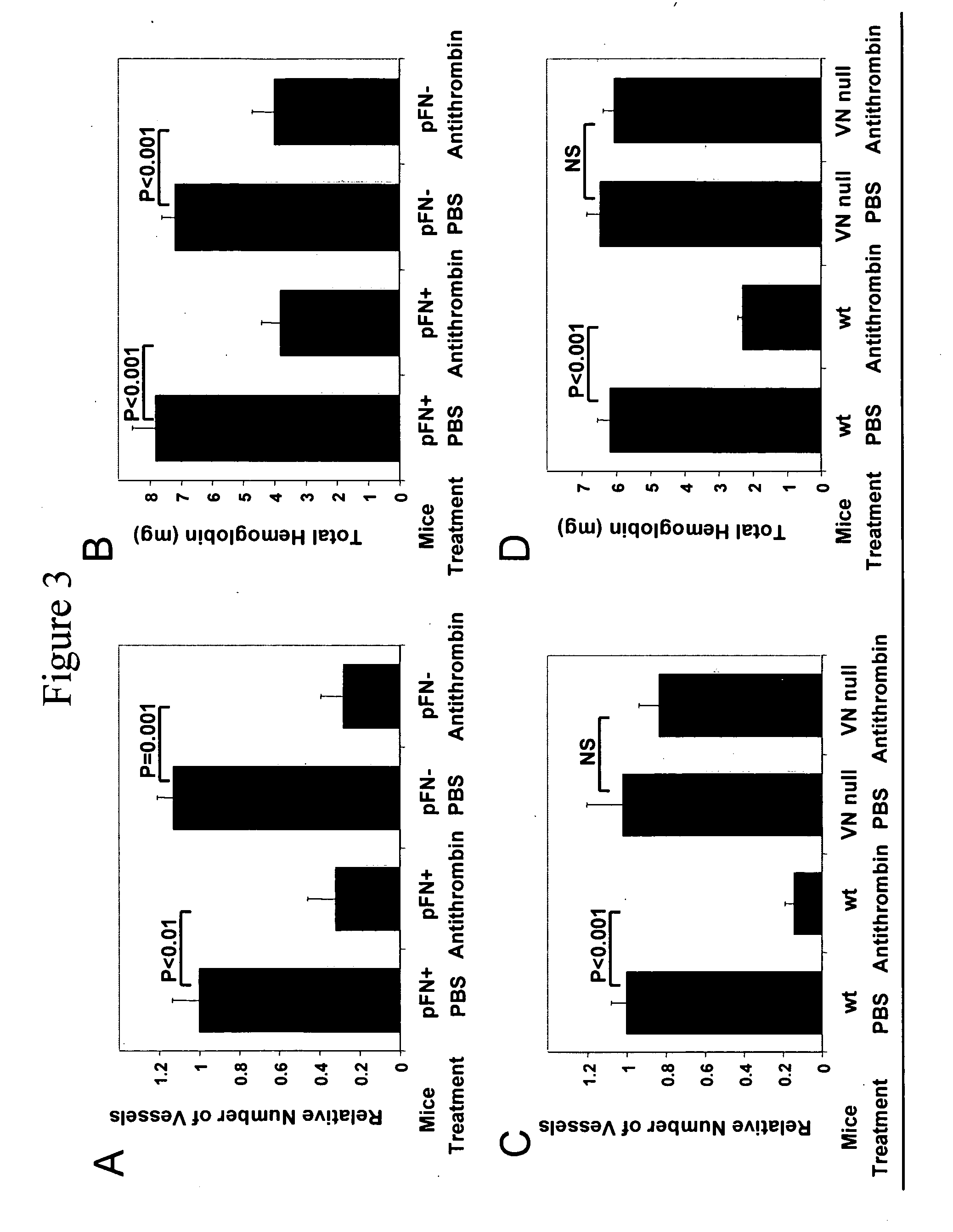Methods and compositions for inhibiting tumor growth and angiogenesis
a technology of angiogenesis and composition, applied in the field of cancer biology, can solve the problems of ineffective angiogenesis inhibitors, excessive growth or insufficient growth of new blood vessels, and damage to normal tissues, and achieve the effect of inhibiting angiogenesis
- Summary
- Abstract
- Description
- Claims
- Application Information
AI Technical Summary
Benefits of technology
Problems solved by technology
Method used
Image
Examples
example i
Anastellin Alone or Combined with Fibronectin Ex Vivo Inhibits Tumor Angiogenesis
[0080] Anastellin and its complexes with fibronectin (superfibronectin) inhibit tumor growth upon systemic administration to mice bearing various types of tumors (Yi and Ruoslahti, supra 2001). This example describes inhibition of tumor angiogenesis by anastellin and superfibronectin.
[0081] Anastellin and III11-C, a control fibronectin fragment from type III repeat 11, were prepared as recombinant his-tagged proteins in bacteria and purified as described in Morla et al., supra (1994), and Pasqualini et al., supra (1996). Human plasma fibronectin was obtained from Chemicon (Temecula, Calif.) and human fibrinogen was obtained from Sigma (St. Louis, Mo.). Fibronectin was converted to superfibronectin by mixing 100 μg fibronectin in 100 μl PBS with 300 μg anastellin in 100 μl PBS as described in Pasqualini et al., supra (1996). Protein solutions were sterilized by filtering through 0.2 μm membrane prior t...
example ii
Anastellin in Conjunction with Fibronectin Inhibits Angiogenesis
[0086] This example describes the effects of systemically administered anastellin on angiogenesis.
[0087] To study anastellin as an angiogenesis inhibitor, a non-tumor angiogenesis model was used. Basement membrane material (matrigel) was impregnated with angiogenic factors and implanted into mice to induce angiogenesis that rapidly supplies the plug with vasculature (Fulgham et al., Endothelium 6(3):185-195 (1999); Ngo et al., Cell Growth Differ 11(4):201-210 (2000)). Matrigel was from Becton Dickinson, (Bedford, Mass.). Recombinant human bFGF and recombinant mouse VEGF were from R&D Systems, (Minneapolis, Minn.). The rat anti-mouse CD31 antibody was from Pharmingen, (San Diego, Calif.). Liquid matrigel containing 100 ng of bFGF or 50 ng of VEGF per ml was injected subcutaneously in the abdominal region of the mouse. Each mouse received one or two 0.5 ml matrigel plugs. The mice were trea...
example iii
Plasma Fibronectin is Necessary for the Anti-Angiogenic Effects of Anastellin
[0090] To test the hypothesis that the interaction of anastellin with fibronectin would be critical to angiogenic activity of anastellin, mutant mice that conditionally lack plasma fibronectin (Sakai et al., Nature Med. 7:324-330 (2001 0) were used.
[0091] Two-month old immunodeficient Balb / c / nu / nu, female mice (Harlan Sprague-Dawley, San Diego, Calif.), wild type C57BL / 6J mice, and transgenic mice were used for the experiments.
[0092] Two plasma fibronectin Cre / loxP conditional knockout mouse lines have been described (Sakai et al., supra (2001)). In one of these lines, Cre expression is under the control of the albumin promoter and causes postnatal elimination of the fibronectin gene in the liver, which is the source of essentially all of plasma fibronectin. The other line expresses Cre in an interferon-inducible manner. These mice have been shown to express less than 0.04% of the normal plasma fibronec...
PUM
| Property | Measurement | Unit |
|---|---|---|
| concentration | aaaaa | aaaaa |
| size | aaaaa | aaaaa |
| adhesion | aaaaa | aaaaa |
Abstract
Description
Claims
Application Information
 Login to View More
Login to View More - R&D
- Intellectual Property
- Life Sciences
- Materials
- Tech Scout
- Unparalleled Data Quality
- Higher Quality Content
- 60% Fewer Hallucinations
Browse by: Latest US Patents, China's latest patents, Technical Efficacy Thesaurus, Application Domain, Technology Topic, Popular Technical Reports.
© 2025 PatSnap. All rights reserved.Legal|Privacy policy|Modern Slavery Act Transparency Statement|Sitemap|About US| Contact US: help@patsnap.com



